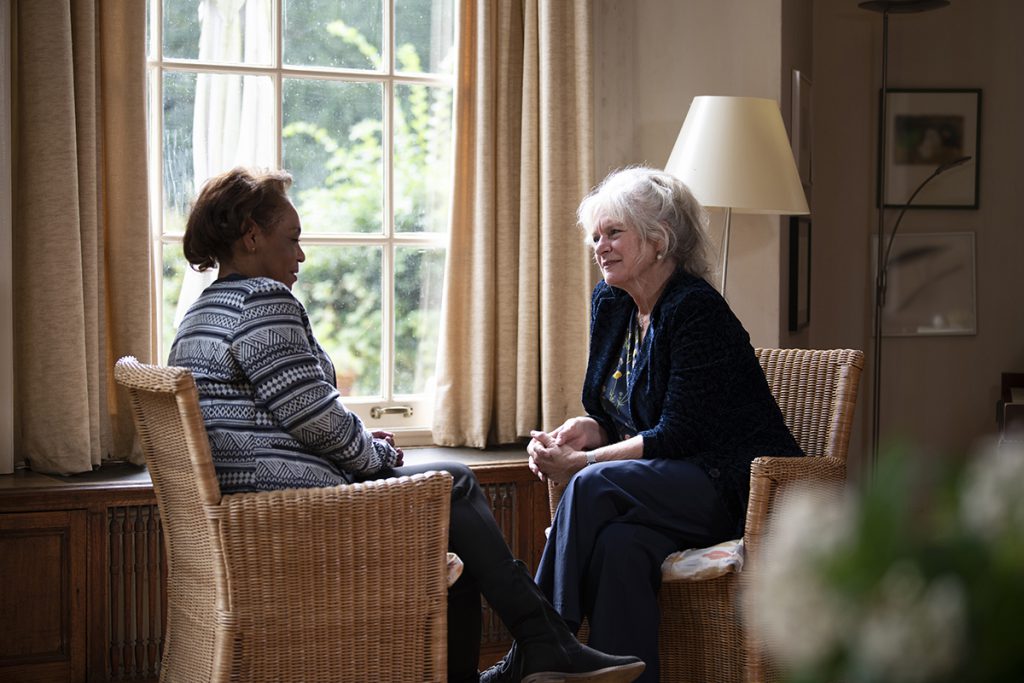5 Tips to Make the Most of Your First Therapy Session
Follow this expert advice to find a therapist who “gets” you — and to make sure your journey is healing.

You've made the commitment to your mental health - an important step in any health-and-wellness journey. Booking an appointment with a therapist is often what comes next. At the very least, it should be on the table.
Consider, up to 14 percent of older adults meet the criteria for generalized anxiety disorder, according to data from Mental Health America and the National Council on Aging. Yet a report from the Pan American Health Organization shows that two-thirds of older adults with mental health problems don’t receive the care they need.
Whether you’re struggling with anxious thoughts or feelings of depression, seeing a therapist can help improve your mental health, says Alyza Berman, LCSW, a clinical social worker and founder and clinical director of The Berman Center, a mental health treatment center in Atlanta.
Toss any notions that at your age, you're too stuck in your thought patterns for therapy to do any good. It turns out the opposite may be true.
A 2021 study looked at how adults ages 18 to 64 respond to therapy compared to those 65 or older. The researchers found that older people actually tend to get more benefits from therapy than younger patients do, especially when it comes to treating anxiety.
Once you’ve decided to give therapy a go, use this guide to make that first call, understand what to expect, and find your way toward healing.
Stay connected, stay active — with SilverSneakers! Choose from dozens of different Community classes, visit a participating fitness location, or view the current schedule of SilverSneakers LIVE online classes. Check your eligibility here.
Step #1: Cast a Wide Net
A good starting point is your primary care provider. Tell your doctor how you're feeling mentally and emotionally and that you're looking for a therapist. They will often be able to recommend someone they think can help.
It's also not hard to search on your own. Many health plans offer a list of in-network therapists. Check their websites or patient portals.
Or browse the American Psychiatric Association online database for a therapist. You can filter your search by location and specialty. There are other online search platforms to try, too: ZocDoc can help you find psychiatrists near you who take your insurance. Therapy Den allows you to find therapists by location, insurance, specialty, and more.
Asking friends or family members for referrals is another option, if you're comfortable with that. And if you get in touch with a therapist who isn't taking on new patients, ask if he or she can refer you to a different therapist, suggests Berman.
Virtual therapy sessions are another option, says Aniko Dunn, Psy.D., a psychologist with EZCare Medical Clinic, which offers online and in-person mental health services in San Francisco.
"Many people are finding that doing a session through a video chat or phone call, an online app, or even texting can feel more private and more comfortable," Dunn says. "It can also reduce the stress of traveling to an office appointment."
You may want to see a few therapists until you find the right one, adds Berman, so the more choices you come up with, the better.
Step #2: Think Through What You Want
As you’re getting ready for your first therapy session, Berman suggests that you think about exactly what it is you’re hoping to get out of therapy and how you’d like the session to go.
For example, she says some people are looking for comfort and support. They'd just like their therapists to listen. Others would rather their therapist offer concrete advice. Some people even prefer their therapists to give them tough love-style guidance.
“You may not know if the therapist you’re seeing at first can provide what you want, but that’s what a first session is about,” Berman says.
Don't be afraid to let the therapist know your preferences and goals. The idea here is to make sure you're a match before you commit to more meetings.
Step #3: Do a Try-Out
That first session can feel awkward, especially if you haven't been in therapy before. However, you'll likely know by the end of the meeting if you want to keep seeing the therapist.
“Many times, by the end of that first hour, you can get a read on whether you click,” Berman says.
Suscríbase a nuestro boletín informativo
Es rápido y fácil: Usted podría estar entre las 13 millones de personas elegibles.
¿Ya es miembro? Haga clic para descubrir nuestros más de 15,000 centros participantes.
Síganos
But it’s fine to be unsure after your first time — so long as you keep trying!
"Some people prefer two or three sessions to know if they feel comfortable with the therapist," she adds. If you don't feel comfortable after that, try someone different.
Remember, you shouldn't expect big changes right off the bat. The first visit usually doesn't go deep into specific problems you're facing or past traumas you'd like to explore (though you can always mention those as the reason you decided to come in).
Think of this as a "kick-off conversation." It's a way to get to know each other and for you to say what's troubling you.
Step #4: Keep the Connection Strong
You want to get the most out of your therapy visits, whether they're online or in person. Berman suggests creating a plan with your therapist that might even include homework. For example, you may try putting some new behaviors into action between one appointment and the next.
Often, the true power of therapy isn't the visit itself. Rather, it's what happens between sessions, when you have time to apply some of the skills you and your therapist have discussed, she adds.
Most important, always be truthful with your therapist and yourself. "Sometimes, people are afraid of saying the wrong thing, or they believe the therapist will judge them," Berman says. "But therapy is about exploring what's coming up for you, and that means being vulnerable. That can't happen without honesty."
¡Tome en línea sus clases favoritas de SilverSneakers!
SilverSneakers members can access live fitness classes and wellness workshops through SilverSneakers LIVE. See the latest schedule and RSVP for classes here.
¿No es miembro? If you have a Medicare Plan, it may include SilverSneakers — at no additional cost. Check your eligibility instantly here.
¿No es elegible para SilverSneakers? Todavía puede obtener más de 200 videos gratis de SilverSneakers On-Demand y mantenerse en contacto con nosotros creando su cuenta online.





